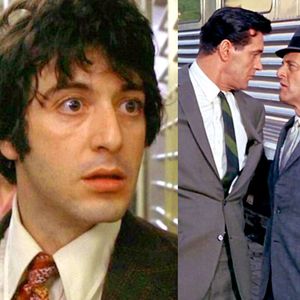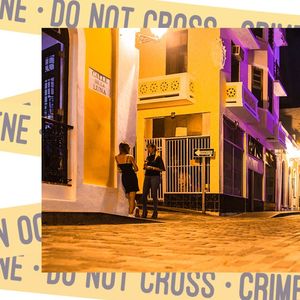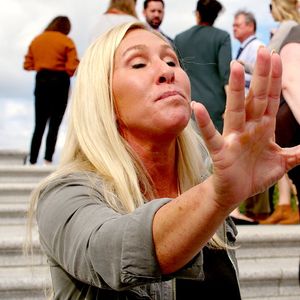Christopher Makos and Paul Solberg met by complete coincidence: they were riding their bikes on Manhattan's west side when they struck up a conversation about travel. During the next few hours, they found a mutual love of adventure. A friendship and working relationship were born. Their affair with Sweden happened under similar circumstances: the Stockholm museum Fotografiska in the winter of 2010 invited the duo, known for their revealing travel photography and anthropological eye, to the opening of a new show of Makos work with his previous collaborator, Andy Warhol.
On the flight to Stockholm, a flight that happened to feature a gay marriage, Makos and Solbeg met Magnus Lindbergh from the tourism group Visit Sweden, who suggested they do a book. Once there, enraptured by a winter wonderland Makos likened to Narnia, the gentlemen agreed. Instead of focusing on just the touristy parts of Sweden, though, their latest tome, Tattoos, Hornets & Fire: The Millennium Sweden Photographs, out now from Glitterati Incorporated and one of Publisher Weekly's top travel books of 2012 , takes the viewer on a visual journey into a more dreamlike world inspired by Stieg Larsson, the late author of The Girl with The Dragon Tattoo and the rest of the Millennium Trilogy.
"This book is kind of a hybrid book about looking at the world of Stieg Larsson a little but also being a tourist and going to Stockholm," Solberg told us.
Here the men talk about their work, Sweden's emerging food culture, and obeying the rules the light.
SLIDESHOW: Images from Tattoos, Hornets & Fire
Out: How did you guys start working together?
Paul Solberg: We met on our bicycles. Chris had just come back from Lanzarote in the Canary Islands. We were both travel enthusiasts and so we just get excited and giggle about travel.
Chris Makos: And I'd asked Paul if he wanted to go on a bike ride up to the George Washington Bridge. I live in the West Village, so that's a serious bike ride. And for me, that's a true test of a future friendship: if you can ask somebody to go on a bike ride to the George Washington Bridge and through New Jersey and back, that's a serious person and a serious bicyclist and a serious traveler. From the onset, discussing this trip about Lanzarote, which is sort of an over-the-top volcanic island owned by the Spanish government, jumpstarted our friendship and our love for travel and adventure and that's why this Swedish book is a continuation of that idea.
PS: The adventure.
And how did this particular project start?
CM: This particular project actually started when Fotografiska invited me and Paul over to the opening of my event, Lady Warhol, and on the plane ride, we were flying over on the SAS and the SAS company was doing this special "love is in the air" promotion.
PS: Campaign.
CM: Campaign. It was about equality, same-sex marriage. The day before, when they were flying over Swedish air space, they did a marriage on the plane.
PS: All the flight attendants came out with different outfits, musical instruments and sang to these rural farmer couple, these two girls and these two guys from like Arkansas.
CM: That was the night before. On our flight, there were two young guys from Arkansas; they were flying over for a sort-of honeymoon at the Ice Hotel, so Paul and I were sitting in the front of the plane, in business class, and we kind of looked around and it was all sort of odd and strange.
PS: Well everyone was photographing each other, I thought, "Boy, it's just such a friendly group." It seemed unusual.
CM: So that was kind of our first experience of Swedish culture -- open, interesting and modern. And it only got better from that and of course that was in the winter of -- what year Paul?
PS: That was 2010.
CM: Right. We were both concerned about what would it be like to go to such a northern country in the snow and all that - well, it ended up being absolutely fantastic in the winter, which was very - I don't know if you know the movie Narnia, but everything is white. The earth is white, the sky is white, because they have very short days. We had gone to Skansen, which is their version of Central Park, but it's an area where the old houses are still there, and that was our first appetizer of this beautiful culture.
PS: Beautiful hair-cuts, handsome men and women; I mean, the population is very attractive, and there's very beautiful bread. Sweden is a great capital of bread, so that's enough to keep you amused.
CM: Speaking of bread. Both of us have done introductions. Mine is called "Pous Pous," which means "Kiss, Kiss" and Paul's text is called "Bread." His text is so amazing. He talks about how you can tell a culture through the bread that they eat. Normally you don't think of Stockholm or Sweden for their food or their bread, but the food there is amazing. So that was our first trip, and on that flight we met Magnus Lindbergh, who represents the Visit Sweden group. We started to talk and one thing led to another; when we came back from that trip, we talked to our publisher and we talked about doing a project on Stockholm or Sweden.
PS: She knew we enjoyed the visual narrative and texture of the Millennium series by Stieg Larsson and said it would be interesting to do a book inspired by that series. The editorial point of view of the book is that we open the book visually as kind of as a tourist, as a first time visit, like your first time seeing parts of Stockholm. And as you get further into the book, we sort of open up the areas and the places that Stieg Larsson lived, visited or are in his trilogy of the Millennium Series books. This book is kind of a hybrid book about looking at the world of Stieg Larsson a little but also being a tourist and going to Stockholm. And I think that's one of the reasons why Publisher's Weekly voted us one of the top 10 books on Stockholm.
You guys are hoping to capture the ambience of Sweden? Can you describe it?
PS: I don't like the work ambience. It doesn't really feel like a Swedish work to use - "ambience."
CM: It's more French.
PS: There's an understated modernity in Sweden. I don't even like modernity. Design in general is at a very high standard -- Stockholm in particular I think is the most intact city: untouched by war or destruction of any European city. It's intact; the initial idea is what it is today. The people are just cool and progressive, and quietly so. But very forward-thinking and enlightened. Also, there's a whole food renaissance where there are chefs -- not this chi chi chef thing, but more like this food coming out: people having restaurants in their sail boats and other surprising places. There's just an organic emergence of food culture that's new in Sweden. I don't know; why do we like it, Chris?
CM: Because it's just so modern. If you've traveled around the world and you've done a lot of the standard places, like London, Paris, Rome, you've done all that, Sweden is a really fresh and surprising.
PS: It really is just incredibly fresh; it's one of these things, it may not be on the top of your list of places to visit in Europe, but once you're there, you have to go back, which is why we've been a total of three times in just under 24 months. There are really two Swedens. There is a winter Sweden and a summer Sweden, and it's like comparing Los Angeles and New York. They are both very special for reasons. The winter Sweden of course is cold and it can be dark, but it can be charming and kind of homey and friendly and warm and generous, whereas the summer Sweden is a very different -- it's much more open.
How did you choose your subjects, both people and the objects?
PS: They choose us. We just follow our nose. We just let the experience unfold.
CM: Emerge. On several of these trips, the Swedish tourist board gave us a tour guide, the same tour guide they gave the Sony Corporation when the movie stars had come to work on the film, the last Stieg Larsson film, and she sort of explained stuff to us and during that process we discovered the stuff between. It was about reading between the lines of her dialogue. And so much of the photography for what we do is based on light, so we kind of follow the light -- not that that's the only criteria, but that's a very helpful one when you're taking pictures, because you take the most striking photos when you know how to obey the rules of the light.
PS: From an editorial point of view, we had to find photographs that transition you, the viewer, from the touristic, happy Swedish feeling...
CM: To transitioning into our Stieg Larsson part of the book, which you can - it's pretty plain, you look at the book and can see it transitions from black and white pictures much in the same way that the "somewhere over the rainbow," Judy Garland...
PS: The Wizard of Oz.
CM: The Wizard of Oz, when it transitions to color.
PS: Our work is sort of ethnographers using our cameras in a way. We don't plan out a certain choreography of the day when we're on the road. We just follow our nose. I studied anthropology, and how we naturally, especially on the road, how we work and take photos is sort of just allowing the experience --
CM: Like Margaret Mead--
PS: Yeah, like Margaret Mead would just sit and let the world around her show her what the experience is, we do that as well. We also engage, but a lot of our photos are sort of these wonderful, happy accidents -- where we engage and sort of have a moment with, but we just allow to unfold in front of us.
For more of Christopher Makos and Paul Solberg's work, visit their website, The Hilton Brothers.
SLIDESHOW: Images from Tattoos Hornets Fire
For more coverage of Stockholm visit OutTraveler.com


















































































